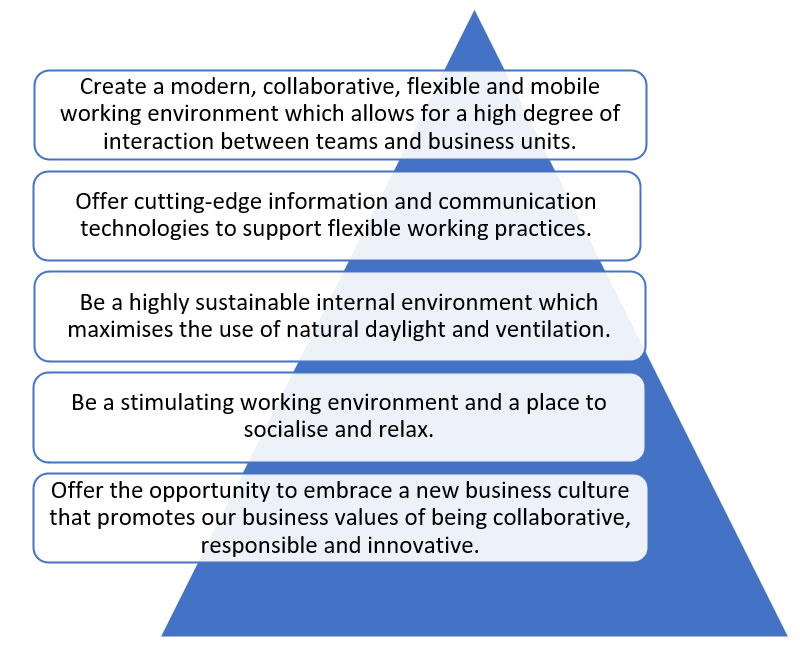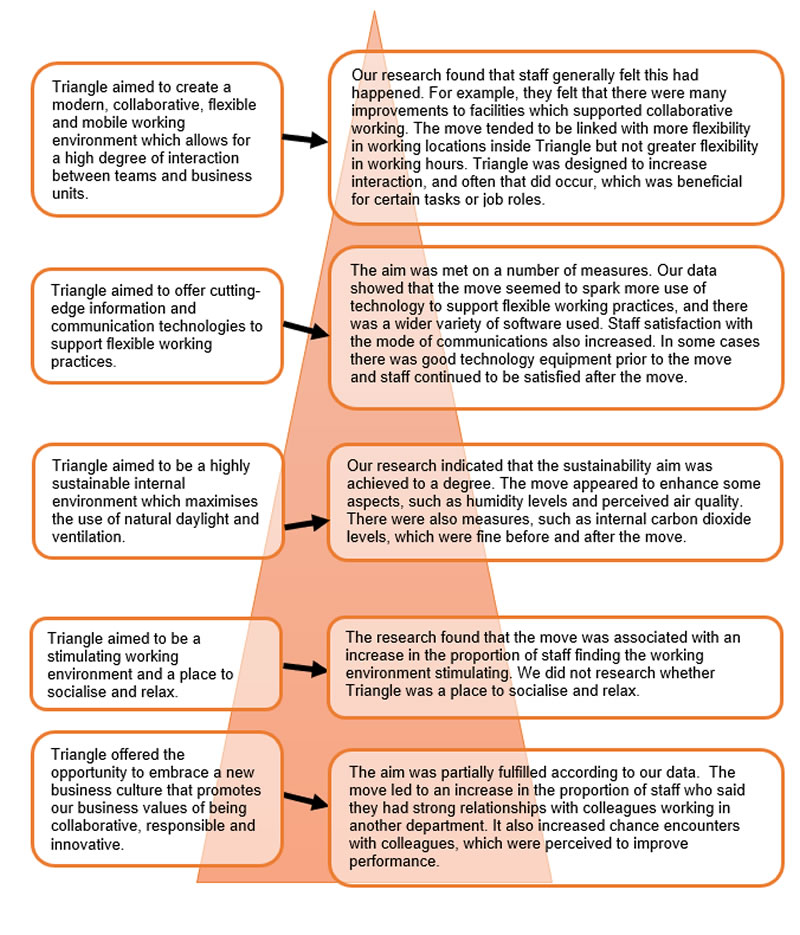10 January 2023
Many organisations use their locations, architecture and arrangements of working spaces to shape work practices, create or embed an organisational culture, and present a certain image. For instance, Google is refurbishing its UK office to better support in-person collaboration and connection. Cambridge Assessment (before merging with Cambridge University Press) undertook an ambitious project to shape work practice and culture by co-locating many staff at a purpose built building, 'Triangle'. The aims of this move are illustrated in Figure 1.
In 2018, staff at our organisation moved from multiple Cambridge office sites to Triangle. This provided the Research Division with a unique opportunity to research how the organisation of an office environment achieved its aims of shaping working practice and culture. Although this research was carried out before Covid restrictions triggered widespread homeworking, it offers very useful evidence which can be used by Cambridge University Press & Assessment (henceforth Cambridge) and other organisations to shape and support working practices now.
Figure 1: The move to Triangle aimed to:

How did we do the research?
Often, businesses illustrate the difference that their services have made using "before" and "after" images: these are readily applied to a variety of contexts, such as new windows being fitted, a drive re-surfacing or a hair re-style. We took a similar approach to our research: we assembled data before and after the move so that we could evaluate the differences. We assembled data available from the normal running of the business (e.g. information logged about the office temperature, the physical distance between desks, or the different types of working spaces), and collected staff views using interviews and questionnaires.
What are the key findings?
Our research found that many aspects of the aims of Triangle were fulfilled. The boxes on the left in Figure 2 give the aims of the move while the boxes on the right describe key research findings which indicate the extent to which the aim was achieved.
Figure 2: Aims of the move to Triangle and key findings relating to them

How can our research be used now and in the future?
Times have changed since this research was carried out. There has been a global pandemic, and restrictions in many countries significantly increased homeworking. In places where restrictions were lifted, homeworking or hybrid working has often been adopted. So how can our research be used by Cambridge and other organisations to inform future practice? Some thoughts on how our key findings link to future practice are given in the table below.
| Examples of key findings |
How the findings can help us with the future |
| The physical environment, and location, that we work in influences how we work and shapes work cultures. |
Designs of home/office workspaces should consider what tasks and work will be done and devise a physical space which supports that work. Some staff may like to be reminded of the way in which they successfully used office space in the past, given the prolonged absence they have experienced. |
| Different types of environments support different types of tasks. For example, certain layouts of buildings and furniture support collaboration. |
| Enhancements in technology can support flexible working. |
The enhancements in technology provide the benefit of improvements in communicating between staff around the globe, at home or in an office, or perhaps for particular tasks. |
This research gathered a lot of data about how our office environment influences how we work and how the move to Triangle contributed to change some working practices. Such data can be compared with data gathered in the future to continue to explore how well the move to Triangle fulfils its aims.
Acknowledgements
We are very grateful to the many colleagues across the organisation who contributed and made this research possible. This includes the departments who provided the data (Premises and Services, Human Resources (People and Culture), Health and Safety and Information Technology) as well as the staff who took part in the interviews or completed the questionnaires.
Researchers who undertook the research are:
Jackie Greatorex, Emma Walland, Carmen Vidal Rodeiro, Nicky Rushton, Melissa Mouthaan, Tom Barrance, Gill Elliott, Victoria Coleman, Isobel Shears.